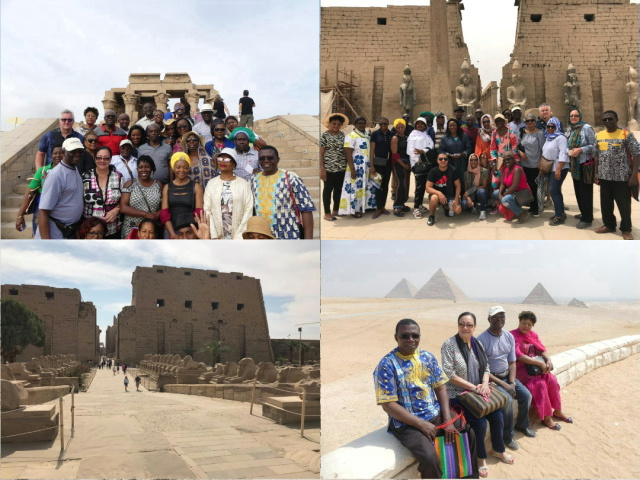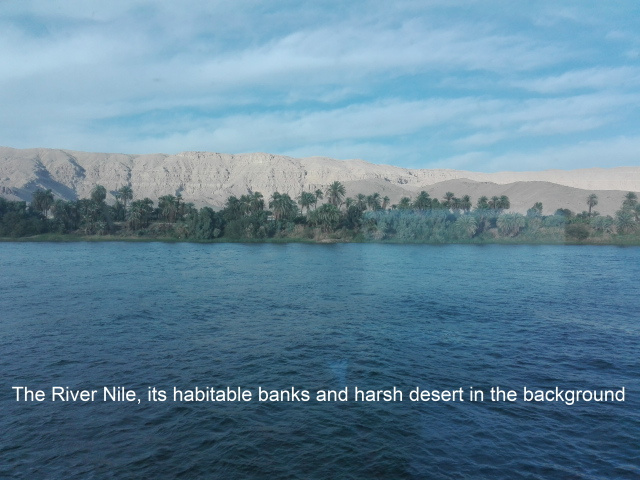14 May 2019
Walking Back in Time in Egypt
Our 32 member trip to Egypt led by Laborex Cameroun started on April 01 2019. Some of us left Douala via Addis Ababa to Cairo, while others proceeded via Paris. The core of our visit was cultural. It was largely a journey 5000 years back in time to try and discover and appreciate the complex maze of Egyptian history and indeed human civilization. Egypt is the only country in the world that has an academic discipline ‘Egyptology’ named after it. Egyptology is the study of old Egyptian history, language, literature, religion and architecture dating back from 5000 years BC up until the 4th century AD. Until you get to Egypt, you will hardly appreciate the richness of that history, the gigantic nature of the monuments and the unbelievable ingenuity of ancient Egyptians. No wonder, Egypt is often referred to as the cradle of civilization.

Egypt’s survival has always depended on the River Nile. 1468 km of the Nile’s 6670 km runs through Egypt from the South to the North. About 95% of Egypt’s 100million people live along the banks of the Nile which constitutes 5% of Egypt’s land surface. About 90% of the country is basically a desert. Farming, animal rearing, fishing, transportation, hydro-electricity, construction and virtually every activity in Egypt depends on the Nile. Without the Nile, there would be no Egypt.
Cairo, the capital of Egypt is a sprawling city of 12 million people with a diameter of about 50 km. One thing anybody visiting Cairo will notice is the large number of uncompleted storey buildings. Some say that uncompleted buildings pay less property tax while our tour guide explained that it is a tradition that family generations take turns in adding floors on the buildings as time passes.

When visiting Egypt as a tourist, be ready to run into aggressive hawkers and beggars on the street, the likes you will meet on some streets of India. In Egypt, it seems payment is required for the least service rendered to a tourist. We had situations where a person offers to use your phone to take your photo and then insist you must pay him for that service. Our tour guide would hire a conductor of a horse driven cart, pay his bill plus a tip on our behalf. That did not still stop the conductor from requesting more money from us at the end of his service. That said, Egyptians are generally warm towards visitors as they and their government understand the benefits they derive from visitors.
According to the World Travel &Tourism Council (WTTC), the travel and tourism sector generated 11.9 percent of Egypt’s GDP in 2018 (totalling $29.6 billion). The sector grew 16.5% and provided 2.48million jobs representing 9.5% of total employment during the period. 8.3 million tourists came to Egypt in 2017. Although no official figures were available for 2018, our tour guide mentioned a figure of 10million. Visitor numbers reached a peak of 14.7million in 2010 before the political upheavals that began in 2011 scaled the numbers down reaching less than 5million at one time.

We kicked off our tour of Egypt by visiting the Pyramids of Giza and the 57m long Sphinx with a human head on the outskirts of Cairo. Later in the day, we took a flight southwards to Luxor (a city of 500,000 people, one hour 10 minutes by air from Cairo. The ancient capital city of Thebes during the height of the reign of pharaohs was here. Today, two huge monuments, Luxor Temple and Karnak Temple, bear a testimony to the grandeur of yesteryear’s Luxor. The royal tombs in the form of tunnels dozens of metres into rocky hills are located on the Valley of the Kings and the Valley of the Queens in Luxor.
From luxor we boarded a cruise boat (a sort of floating 5 star hotel) for a three day trip on the Nile to Aswan which is located some 210 km South of Luxor. Our boat had 48 cabins (the equivalent of hotel rooms) and all facilities you will have in a normal hotel. Our tour guide said that there were about 300 such vessels plying the Nile. On the way to Aswan, we stopped at Esna and Edfu to visit the temples there both of which are more than 2300 years old.

Aswan (pop300,000) is best known for the dam first built in 1902. A newer dam... the Aswan high dam inaugurated in 1971 eclipsed the old one. The 111m high dam created lake Nasser the largest artificial lake in the world. Lake Nasser is 550 km long with average depth of 25.2m. Nubian villages both in Egypt and Sudan were submerged by the lake necessitating the relocation of people and some monuments. In Aswan, apart from visiting the dam, we visited the temple of Kom-ombo and the relocated temple of Philae on Agilkia Island. We had the opportunity to interact with the dark skin Egyptian Nubians. We visited their villages, rode their camels and had an evening of Nubian music and dance.
We rounded our visit to Aswan and took a flight for Cairo. One more day in Cairo gave us the opportunity to visit the Egyptian museum in Cairo. The museum has some of the highest collection of ancient artefacts in the world including mummified bodies more than 3500 years old.
When you visit Egypt, words like obelisk, hieroglyphics, sphinx, pyramid, pharaoh, mummy or papyrus that you will otherwise glance over them in a book, become real. You are seeing and touching human civilization dating back to 5000 years
Related videos
Visiting the Pyramids of Giza near Cairo
https://www.youtube.com/watch?v=YvOaqus4xAY
Inside the 2000 years old temple of Karnak in Luxor
https://www.youtube.com/watch?v=-6-bgSTlNK8
Camel ride with Nubians in Aswan
https://www.youtube.com/watch?v=JVa0ftSeA1Q
Njei Moses Timah
|